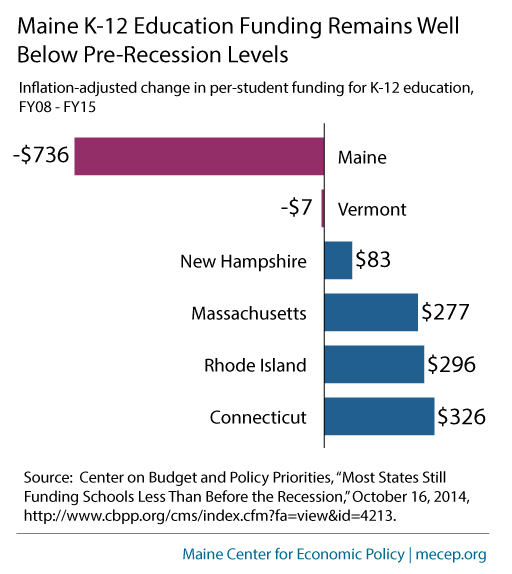Maine’s future workforce, ability to compete in global economy at risk
Maine cuts to school funding since the start of the recession are among the highest in the nation, and the deepest in New England, according to a new study released today. The report by the non-partisan Center for Budget and Policy Priorities (CBPP), Most States Still Funding Schools Less than before the Recession, found that Maine has cut investment in K-12 schools by 13.3 percent since 2008, a deeper cut than 38 other states. Among New England states, Maine has cut per capita student spending by $736 since 2008, while Vermont per student spending is $7 below pre-recession levels and the other four states have all increased spending. The report is available online.
“A well-educated workforce fosters economic growth,” said Garrett Martin, executive director of the Maine Center for Economic Policy. “These unnecessary cuts weaken our schools and could make it harder for the next generation of Maine workers to compete for highly skilled jobs in the global economy. We are shooting ourselves in the foot by cutting our investment in our schools and students.”
CBPP identified Maine as one of 20 states that continued to cut education funding this year, even as the economy recovers, leaving spending per student $736 below pre-recession levels, taking inflation into account.
Martin noted that Maine state revenue declined sharply during the recession. But instead of addressing budget shortfalls by taking a balanced approach that includes new revenues, Maine has relied mostly on cuts to state services, including education.
“Reducing investment in schools has long-term economic consequences,” Martin said. “Quality elementary, middle, and high school education provides a crucial foundation that allows children to go on to succeed in college and in the workplace.”
Martin cited efforts by many schools across Maine to implement proven reforms to strengthen their schools and better educate students, such as reducing class sizes, improving teacher quality, increasing learning time, and expanding early education.
“But these improvements cost money and deep funding cuts undermine their efforts,” Martin said. “In fact, state spending cuts have forced many schools to move in the wrong direction.”
“At a time when the nation is trying to produce workers with the skills to master new technologies and adapt to the complexities of a global economy, states should be investing more – not less – to ensure our kids get a strong education,” said Michael Leachman, director of state fiscal research at CBPP and co-author of the report released today.
For a copy of the full report, click here.



